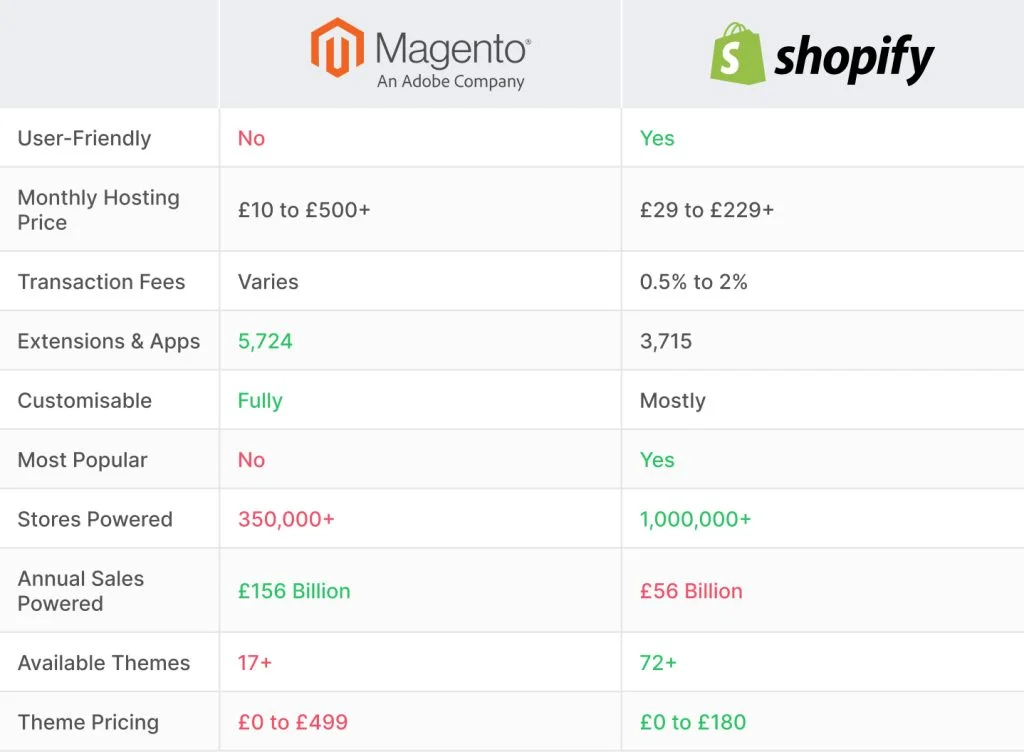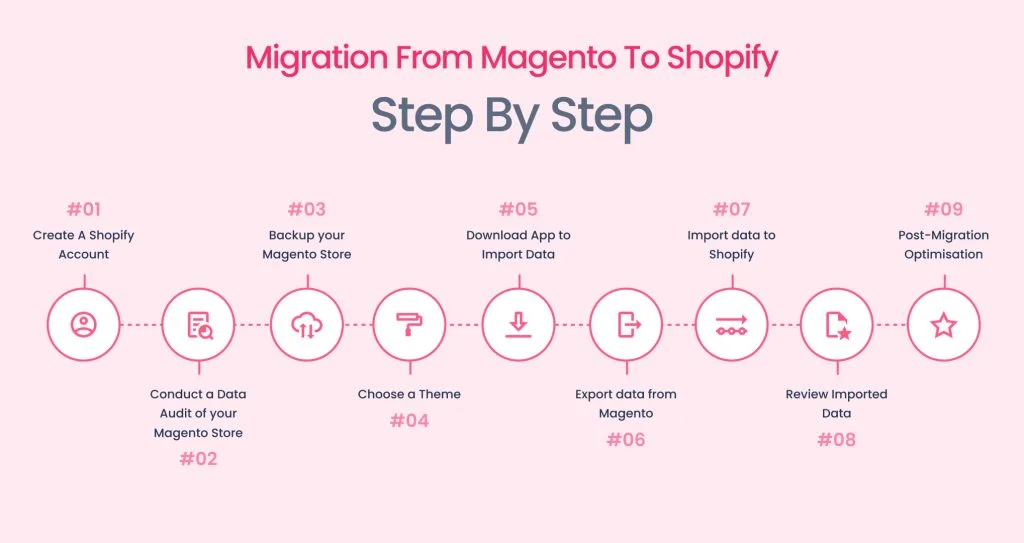How to Migrate from Magento to Shopify: Step-by-Step Tutorial
Do you know there are about 127,656 live websites on Magento and 4 million live websites on Shopify? These stats are enough to understand Shopify is becoming popular day by day.
Shopify, as an eCommerce platform, is the choice of many people out there. But what if you have chosen an Magento Agency instead? Do not worry, you can easily migrate your data from Magento to Shopify Agency by following a few simple steps. You will get to know all about it further in this article.
So, get ready to know how you can migrate your data from Magento to Shopify.
Why Migrate from Magento to Shopify?
Many people are migrating from Magento to Shopify because Shopify is comparatively more user-friendly and offers brilliant tools and features. Here are some of the reasons people are migrating from Magento to Shopify:

- No technical knowledge needed
- Easy-to-use eCommerce platform
- 24/7 customer support
- Multi-channel selling
- Mobile responsive themes
- Minimal time and effort required for maintenance of the store
- Better security
- Low maintenance charges
- Wide range of Shopify apps
Why Shopify is the best platform for your business.
Is It Complex to Shift from Magento to Shopify?
Moving to a new place always gives a scary feeling. The decision to move is tough, but the real challenge arises when you start planning. What to move first? How to shift things so that they stay the same? What to use to migrate? And many such questions.
Moving from the Magento store to the Shopify store is also the same. It comes with a lot of fears and questions in mind. We won’t lie, shifting from Magento to Shopify is not easy. But this all can be possible with the help of a Shopify agency, or you can hire a Magento Developer. With them, migrating from one platform to the other will become a cake walk and you do not need to worry about anything. They will take care of every possible thing.
What can be Transferred from Magento to Shopify?
You might be wondering what can be transferred from Magento to Shopify, right? So, you can transfer:
Product Visuals:
Visuals mean the shape, size, and color of the products. All the details of the order, including payment details, purchase amount, shipping address, billing, and customer name, can be migrated from Magento to Shopify.
Moreover, the static page content like contact pages, blogs as well as other CMS pages of the websites can also be transferred.
Product Categories:
These consist of all the products on a website along with their information like name, description, status, SKU, price, URL, manufacturer, images, weight variants, mega titles, special price, meta descriptions, number of goods in stock, and base images.
If you choose right Magento Agency in UK, Click Here.
Step-By-Step Tutorial on How to Migrate from Magento to Shopify
This step-by-step tutorial will help you navigate from Magento to Shopify by following a few basic steps.

Create A Shopify Account
Yes, first things first! Set up your Shopify account. You can take a first free trial for 14 days without spending a single penny.
You can familiarise yourself with the robust eCommerce tools without committing to the platform. But you need to pay once the trial period is over. There are three pricing plans:
- Basic Shopify ($29/ month)
- Shopify ($79/month)
- Advanced Shopify ($299/month)
If you are a beginner and wish to start a business, then basic Shopify would work right for you. It has all the features required to start a business. Next, Shopify offers plenty of tools needed to expand a business. And the last Advanced Shopify has all the tools that are needed to take your business to the next level.
No, you do not need to pay the setup fee for any of the three above-mentioned plans. You are just required to pay monthly fees.
How much does Shopify cost?
Conduct a Data Audit of your Magento Store
Your Magento store has critical data including your customer data as well. That is why you must perform a data audit of your eCommerce store. It will help you in creating an inventory consisting of only Magento data.
Moreover, it will include the name of the product and details, customer name, password, etc. Also, make sure you are finding the access details of your Magento store to build a strong connection between the source and the target store.
Backup your Magento Store
Hurry spoils the curry! So, make sure to
Take the whole migration process slowly and patiently. One mistake can be very expensive for you! So, before transferring your data from Magento to Shopify, it is very significant to make a separate database backup of your eCommerce store. Additionally, back up your media files as well.
This can be done just within the Magento platform only, by using the admin panel sidebar. Backing up your data is very important to keep your data safe and secure. At the time of shifting from Magento to Shopify, there are two key areas that you should focus on. It minimises the impact of migration on your customers and backs up your data.
Choose a Theme and Install Applications
Now comes the time to set up your Shopify store. Based on your requirements, you can pick a theme for your Shopify store. You can customise the same in the future for your eCommerce store. However, let the shifting procedure complete to customise any theme. By doing so you can avoid potential risks in the future.
Now, you can install the application according to your needs. For example, you can install a product review app if you have product reviews on your online store.
Download An App to Import Data
A lot of apps are available in the Shopify app store, and Store Importer is the most useful application of them all. It is a simple-to-use, free application for transferring data to Shopify.
Visit the Shopify admin page, tap on ‘Apps’, and then choose ‘Store Importer’ and adhere to the instructions to download it. This application is convenient to use and makes your work easy.
In addition to this, there are other applications for importing your data as well. They are LitExtension store migration, Matrixify, Multichannel importer, and Cart2Cart store migration application.
Export data from Magento
Now it is the time to pack your bags and move on! Yes, finally, pack up all your data into the boxes and drop it in a new location. That means exporting your product and customer data onto a file to make it understandable to the other applications.
You can export your data from Magento through the ‘Admin Sidebar’, which you have used to back up your online store. The process of exporting data is quite simple. Just:
- First, tap ‘System’ on the Admin Sidebar, then ‘Transfer Data’> ‘Export’.
- After that, choose whether your entity type is the customer’s main file, products, or customer addresses within the export settings.
- Choose ‘XML’ in the export file format if you use the ‘Import store’ application.
- Choose ‘CSV’ if you want to import the data manually
- Choose ‘Transporter’ to export data on Magento.
However, if you wish to export the customer’s main file, export products, or customer addresses, then you should repeat the same process for each one of them. After this is done, you will have your data on a spreadsheet that can be conveniently digested by Shopify. And this is how you can complete the whole shifting process smoothly.
Import data to Shopify
Importing your data from Magento to Shopify is the most important step of the whole migration process. Follow the below-mentioned steps for a smooth import process.
- Visit the Shopify admin page, then go to ‘Apps’, then tap on ‘Import store’
- Choose your platform, which is ‘Magento’.
- Select the ‘Add file’ option to upload the files
- In case you have uploaded your data from the Magento store, then tap on the CSV file.
- Tap ‘Continue Import’, then ‘Import’ to complete the process.
- If you wish to import products separately, then login to Shopify, go to the ‘Products’ option, and then tap on ‘All Products.’
- Select ‘Import’.
- Choose ‘Add file’ and then add the product CSV file.
- After that tap on ‘Upload File’.
However, if you wish to import the customer’s data separately, then you can follow the same steps. But you must keep in mind that data should be in order while importing. Also, the passwords of your customers cannot be transferred to Shopify as they are encrypted. You can just transfer customer records and not customer accounts.
Review Imported Data
After you are done importing the data, then you must review it to ensure that you do not miss out on anything. Updating and reviewing data is very simple when it comes to Shopify.
Here are some of the common issues that you can encounter while reviewing the data:
- You need to edit the missing data naturally.
- You need to add some customers and products manually by using the ‘Customers and Products Import’ option.
- In case of bundled products and failed import, you need to manually add the data using the product bundling application from Shopify.
- Another problem is the successful import of unpublished products. To fix this issue, change the availability of products in Shopify.
In addition to this, sometimes tags will also be added to the imported data records; Imported products will lack the dimension, and some products will not upload. You must fix these issues manually.
Post-Migration Support and Optimisation
Once the migration process is completed, it doesn’t end here. You need to watch the new applications, how they are performing, and how they are impacting your store’s operations.
Moreover, the app developers, as well as Shopify, release new updates too frequently. So, make sure to stay well informed about all these updates and how they can benefit your store.
Consider the Cost Implications
Various Shopify applications need a monthly subscription. So, make sure to consider these costs as a part of your expenses. Custom development can be a bit costly, so it is crucial to budget accordingly for these expenses.
5 Tips to Optimise Your Shopify Store After Migration
Follow these five quick tips to optimise your Shopify store.
- The pages that load fast enhance user experience. So, make sure to resize and compress the images to improve the loading time of the pages.
- Ensure quick and simple navigation by organising the products into different categories and menus. This assists the customers in finding what they are looking for easily.
- Optimise your description, meta tags, product titles and meta description. This will assist you in ranking your store higher on the search engines.
- Make your store mobile friendly. That means making it convenient to use on mobiles.
- To reduce cart abandonment, try to simplify the checkout process. Minimise the steps and provide different payment options for a smooth and seamless experience.
Conclusion
To fully exploit the potential of their eCommerce store and fulfil their objectives, many Magento users are shifting to Shopify. While Magento is free and has multiple functionalities, Shopify is an all-in-one eCommerce platform that offers robust features. In this tutorial, we have explained how you can easily shift your Magento store to Shopify.
In addition to this, we have also discussed what all you can transfer and how you can optimise your Shopify store after the process of migration. All in all, this guide will assist you to shift seamlessly from Magento to Shopify. However, if you need help with transferring your eCommerce store you can contact us.

Comments
Post a Comment